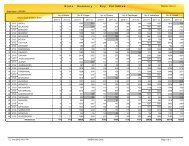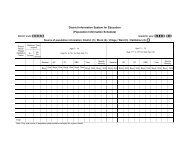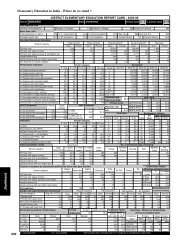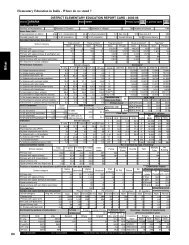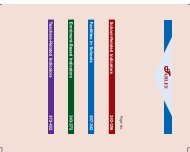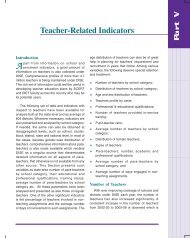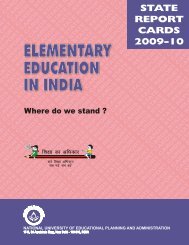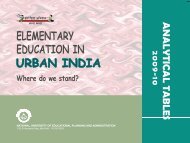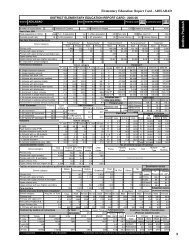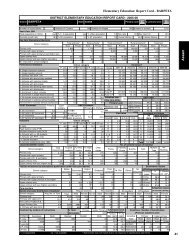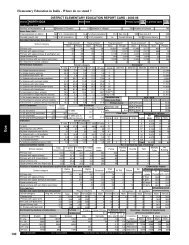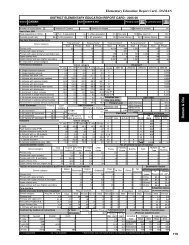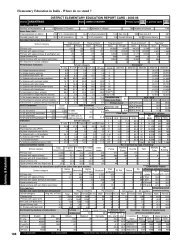Volume II - DISE
Volume II - DISE
Volume II - DISE
You also want an ePaper? Increase the reach of your titles
YUMPU automatically turns print PDFs into web optimized ePapers that Google loves.
5. Limitations of the Data<br />
Raw data presented in the document or used for calculating indicators are essentially based on data provided by<br />
the State Project Offices through annual data collection under SSA, (<strong>DISE</strong>) and the correctness of data reported<br />
is not checked by NUEPA. NUEPA is committed to provide professional and software support to all States and<br />
UTs as well as for dissemination and analysis of data. In no way, it is involved in data collection as such and<br />
therefore the accuracy and truthfulness of the data rest with the States/UTs. Further, the State Project Directors<br />
have certified that data is free from errors & inconsistencies and hence the same may be merged into the national<br />
database maintained at NUEPA, New Delhi.<br />
Procedures for the data validation and verification of sample data capture formats at the district level have been<br />
prescribed, and the districts reported the steps taken by them to ensure quality and reliability of data collection.<br />
The <strong>DISE</strong> software also checks for internal inconsistencies in the data and generates reports for verification by<br />
the District Project Office. The State Project Office while transferring the data from the district to the state<br />
database ensures that the data received from the district is complete and free from any inconsistency. Most of<br />
the states have engaged an independent agency for sample checking of data. At the national level, data from the<br />
State Project Office is received to ensure compliance with various quality control measures. Despite these<br />
efforts, some inconsistencies and missing data are observed at the national level. In some cases data on key<br />
elements is found missing. In view of these problems, data presented in the Report Cards may not exactly match.<br />
In some cases, the discrepancies could not be resolved at the national level. For these reasons, data on such<br />
variables is not reported in a few districts.<br />
Needless to mention that the percentages, rates and ratios presented in the report cards are based on the schools<br />
that have responded to a particular question and hence may not be applicable to the entire district. Thus, schools<br />
by management, there location in rural and urban areas, type of schools, schools by category, enrolment (General,<br />
SC. ST, OBC, Muslim and by medium of instructions), pupil-teacher ratio, student-classroom ratio, percentage of<br />
girls in primary and upper primary classes and other such indicators should therefore be viewed in the light of<br />
these limitations.<br />
Over a period of time, the number of schools covered under <strong>DISE</strong> increased significantly. During 2008-09, data<br />
has been collected from more than 1.29 million schools, with a comprehensive profile of more than 5.79 million<br />
teachers, also being maintained by <strong>DISE</strong>. Despite best efforts, it is still possible that the field agencies might have<br />
not covered all the recognised schools imparting elementary education supposed to be covered under <strong>DISE</strong><br />
which is specifically true for schools under private managements. A few districts have collected data from these<br />
schools while others might not have covered all such schools. Despite significant increase in number of private<br />
schools covered under <strong>DISE</strong> (250 thousand in 2008-09), field level functionaries reported that data from a few<br />
private un-aided schools couldn't be obtained for the one or the other reason. We are trying to reach all such<br />
schools and are hopeful that these efforts will be reflected in the following year.<br />
It has also been observed that a few schools did not report age and grade matrix which is crucial in knowing the<br />
status of elementary education. A few districts even did not report enrolment of Grade V<strong>II</strong>I. Therefore, enrolment<br />
in upper primary classes does not present the complete picture in Grades VI-V<strong>II</strong>I; thus GER and NER may not<br />
give correct portrayal of universalisation in such districts and the same may be considered as percentage of<br />
children of an age-group enrolled in schools that reported data under <strong>DISE</strong>. The remaining children may either be<br />
out-of-school or enrolled in unrecognized schools, Education Guarantee Schools (EGS), non-formal education<br />
centers and other learning centers not covered under <strong>DISE</strong>. Irrespective of the school structure, enrolment ratio<br />
at the primary level is based on Grades I-V and of the upper primary level, Grades VI-V<strong>II</strong>I.<br />
The state-specific single-age population projected by the Office of the Registrar General of India is used to obtain<br />
6-11 and 11-14 year child population at the district level which is used to compute GER and NER. The districts<br />
should feel free to revise enrolment ratio in the light of more recent estimates of child population, if available<br />
through the household survey.<br />
xxiii




